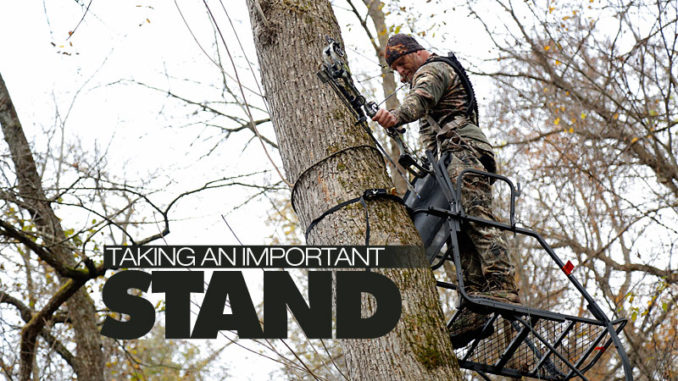
Several factors are important in finding and selecting that perfect tree for an archery stand for deer. Here are some easy to follow tips.
Deer hunting, especially with archery gear, requires lots of preseason preparation for a successful outcome. Assuming you have your bow dialed in and have taken proper scent-control measures, stand placement is the main factor that will determine your success — or lack thereof. With today’s equipment, a majority of bow hunters are confident in their shooting ability out to at least 30 yards. Keeping that 30-yard maximum range in mind, think about the following: You have to choose a tree-stand or ground-blind location that deer will pass within a 30-yard radius of, during shooting hours, offering a broadside or quartering away shot. The deer must do this all while totally unaware of your presence. Let’s take this one step further and target trophy bucks, or even more specifically, one particular buck. Sound like a tough choice? It most definitely is. The following are some guidelines for bow-stand placement and strategies I have adopted after 30 years of bowhunting white-tailed deer. By no means do I consider myself an expert. More often than not, the deer win. But I learn something every time I’m in the woods with archery gear, and I’m hoping this will help some of you become more successful.
It’s all about the groceries
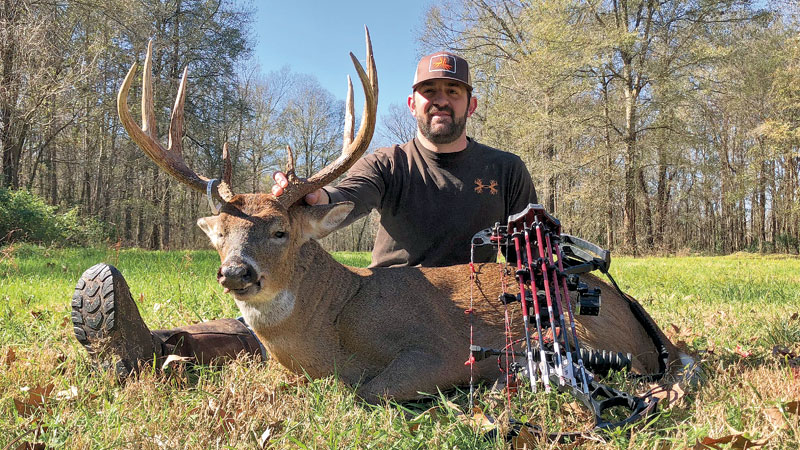
During early archery season, deer are focused almost entirely on food. They are coming off the late-summer stress period, and they need to consume huge amounts of food to build their bodies up for the upcoming rut and winter. This concentrates deer around food sources such as food plots, agriculture fields and mast trees. Warmer temperatures cause deer to bed down early in the morning and get up to feed late in the evenings. Due to an abundance of food and cover, deer — especially bucks — rarely travel very far from their beds. This makes morning hunting a losing proposition in most places. It is nearly impossible to get ahead of or around deer that are headed back to bed in the predawn hours without spooking them, which will quickly educate them to the fact they are being hunted. For these reasons, a majority of my early season hunts are in the evening over or near a food source close to a cutover or other thick area. I use mornings to practice shooting or to scout new areas.
Food plots
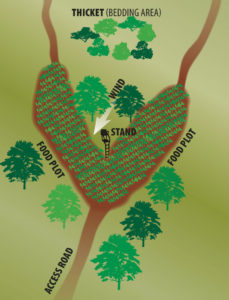 Food plots are great places to hang a stand for early season bowhunting. Their tender, green growth concentrates deer, while offering great visibility and open shots. When hanging a tree stand on a food plot, I try to choose a tree that offers the best opportunity to cover the majority of a small plot or where a larger plot narrows down to funnel deer closer to me. Inside corners are great places for a close shot at a big buck. That’s because they love to slip in and stand just inside of the wood line where they can watch the field on either side of the corner. I look for a tree situated downwind of the plot with easy access. Ideally, I also try to pick a tree where the sun will be behind me as it sets in the evening. It’s no fun squinting into the sun all afternoon, and it makes it more difficult for deer to spot you. Try to choose a tree with sufficient cover. A major problem with sitting on a food plot is leaving your stand undetected at dark when the field is often filled with deer. One good solution is to have a buddy pick you up in a vehicle so that the vehicle spooks the deer. That way, they don’t notice you climbing down. Another trick I have used in recent years is to play a coyote howl on my smart phone. Although this runs the deer off, I believe they think it is random and won’t avoid the area in the near future.
Food plots are great places to hang a stand for early season bowhunting. Their tender, green growth concentrates deer, while offering great visibility and open shots. When hanging a tree stand on a food plot, I try to choose a tree that offers the best opportunity to cover the majority of a small plot or where a larger plot narrows down to funnel deer closer to me. Inside corners are great places for a close shot at a big buck. That’s because they love to slip in and stand just inside of the wood line where they can watch the field on either side of the corner. I look for a tree situated downwind of the plot with easy access. Ideally, I also try to pick a tree where the sun will be behind me as it sets in the evening. It’s no fun squinting into the sun all afternoon, and it makes it more difficult for deer to spot you. Try to choose a tree with sufficient cover. A major problem with sitting on a food plot is leaving your stand undetected at dark when the field is often filled with deer. One good solution is to have a buddy pick you up in a vehicle so that the vehicle spooks the deer. That way, they don’t notice you climbing down. Another trick I have used in recent years is to play a coyote howl on my smart phone. Although this runs the deer off, I believe they think it is random and won’t avoid the area in the near future.
Mast trees
Mast trees, especially oaks, are a huge draw for whitetails in the early fall. Acorns contain huge amounts of fat that help deer gain weight rapidly. Because acorns are seasonal in their availability, deer will forsake almost every other food source to feed under a hot oak tree. The problem is several trees are often dropping at the same time. So choosing the “right” tree on any particular evening can be a matter of luck. Trees that are closer to thickets or cutovers are more likely to see daytime use, so I focus on them. If multiple oaks in an area are dropping acorns, I try to find a stand tree that offers the opportunity to shoot to as many of them as possible within 30 yards. I always try to put my stand near the tree with the most feeding sign and fresh droppings. But this can change daily, so it can be frustrating. Soft mast such as persimmons and crab apples can be even better, especially the first week or two that they begin to drop. Resist the temptation to set up right on top of food trees. Instead, try finding a tree 20 yards or farther away to remain unnoticed.
Cutovers
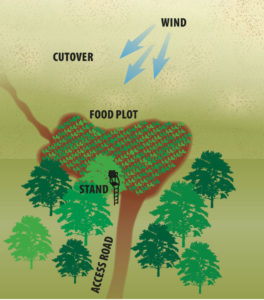 Although they are a food source, in that they contain lots of browse, cutovers primarily serve as a bedding area for deer. Many properties have so many food sources, it can be difficult to single one out to hang a stand over. In these cases, hunting the edge of cutovers can be a great strategy. I try not to penetrate into the cutover very far so I don’t spook bedded deer. You want to set up on the downwind side of the cutover. There is often a heavily used deer trail within 20 yards of the inside edge of a cutover, running parallel to the edge. Deer often walk this trail, peering out into the more open woods while remaining in the thicker cover of the cutover. Positioning your stand so that you can shoot to this trail is a great strategy that will greatly increase your shot opportunities.
Although they are a food source, in that they contain lots of browse, cutovers primarily serve as a bedding area for deer. Many properties have so many food sources, it can be difficult to single one out to hang a stand over. In these cases, hunting the edge of cutovers can be a great strategy. I try not to penetrate into the cutover very far so I don’t spook bedded deer. You want to set up on the downwind side of the cutover. There is often a heavily used deer trail within 20 yards of the inside edge of a cutover, running parallel to the edge. Deer often walk this trail, peering out into the more open woods while remaining in the thicker cover of the cutover. Positioning your stand so that you can shoot to this trail is a great strategy that will greatly increase your shot opportunities.
Conclusion
The perfect stand tree is situated 22 yards downwind from the trail or food source, with ample cover, the sun at your back, and easy undetectable access. These trees exist but are the exception rather than the rule. Hanging stands often requires some degree of compromise on one or more of these criteria. But I always try to compromise as little as possible. Put some thought into your stand locations this season, and your success should increase.
What makes a great stand tree?
When hanging a tree stand, I primarily focus on four considerations.
-
- Can I set up with the wind in my favor? There’s no sense hanging a stand where the predominant wind is blowing towards the deer. You just can’t beat their noses most of the time.
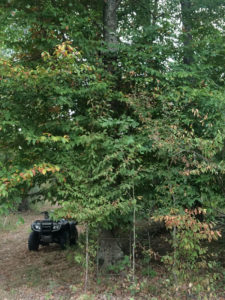
- Can I access AND leave my stand without spooking the deer I’m hunting? It only takes a few encounters on the way to or from your stand for deer to realize they’re being hunted, making them avoid your stand area, or even worse become nocturnal.
- Consider the shot angle and distance. I try to pick a tree that will give me the maximum opportunity for a shot at a properly angled deer within 30 yards. This may seem obvious, but I’ve seen a lot of people compromise on this one, stretching it beyond their comfortable shooting range.
- Does the tree offer sufficient cover to conceal me well enough to draw my bow undetected? Drawing the bow requires a fair amount of motion, and an open tree will result in missed opportunities at the moment of truth.




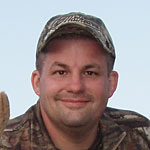
Be the first to comment